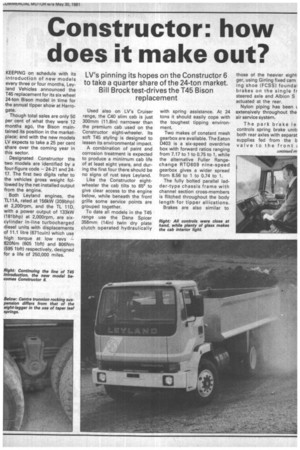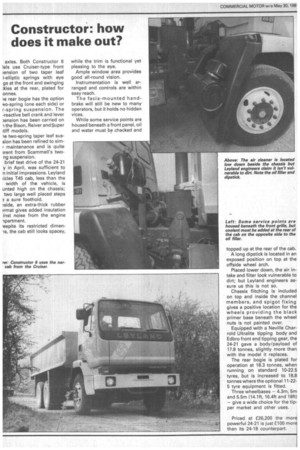Constructor: how does it make out?
Page 61

Page 62

If you've noticed an error in this article please click here to report it so we can fix it.
KEEPING on schedule with its introduction of new models every three or four months, Leyland Vehicles announced the T45 replacement for its six wheel 24-ton Bison model in time for the annual tipper show at Harrogate.
Though total sales are only 50 per cent of what they were 12 months ago, the Bison maintained its position in the marketplace; and with the new models LV expects to take a 25 per cent share over the coming year in this sector.
Designated Constructor the two models are identified by a four-figure code — 24-21 and 2417. The first two digits refer to the vehicles gross weight followed by the net installed output from the engine.
Both Leyland engines, the TL11A, rated at 156kW (209bhp) at 2,200rpm, and the TL 11D, with a power output of 133kW (181bhp) at 2,000rpm, are sixcylinder in-line turbocharged diesel units with displacements of 11.1 litre (671cuin) which use high torque at low revs 820Nm (605 1bft) and 806Nm (595 1bft) respectively, designed for a life of 250,000 miles. Used also on LV's Cruiser range, the C40 slim cab is just 300mm (11.8in) narrower than the premium cab used on the Constructor eight-wheeler. Its soft T45 styling is designed to lessen its environmental impact.
A combination of paint and corrosion treatment is expected to produce a minimum cab life of at least eight years, and during the first four there should be no signs of rust says Leyland.
Like the Constructor eightwheeler the cab tilts to 65° to give clear access to the engine below, while beneath the front grille some service points are grouped together.
To date all models in the T45 range use the Dana Spicer 356mm (14in) twin dry plate clutch operated hydraulically with spring assistance. At 24 tons it should easily cope with the toughest tipping environment.
Two makes of constant mesh gearbox are available. The Eaton D403 is a six-speed overdrive box with forward ratios ranging from 7.17 to 1 to 0.75 to 1, while the alternative Fuller Rangechange RT0609 nine-speed gearbox gives a wider spread from 8.56 to 1 to 0.74 to 1.
The fully bolted parallel ladder-type chassis frame with channel section cross-members is flitched throughout the body length for tipper allications.
Brakes are also similar to those of the heavier eight. ger, using Girling fixed cam ing shoe (FCSS) foundai brakes on the single fr steered axle and Albion S actuated at the rear.
Nylon piping has been extensively throughout the air service system.
The park brake le controls spring brake unit: both rear axles with separat supplies fed from the b valve to the front z axles. Both Constructor 6 lels use Cruiser-type front )ension of two taper leaf i-elliptic springs with eye gs at the front and swinging :kles at the rear, plated for onnes.
le rear bogie has the option vo-spring (one each side) or r-spring suspension. The -reactive bell crank and lever )ension has been carried on the Bison, Reiver andSuper ;tiff models.
le two-spring taper leaf sussion has been refined to sim, maintenance and is quite arent from Scammell's twong suspension.
brief test drive of the 24-21 y in April, was sufficient to n initial impressions. Leyland licles T45 cab, less than the width of the vehicle, is unted high on the chassis; two large well placed steps a a sure foothold.
Iside, an extra-thick rubber If-mat gives added insulation inst noise from the engine 1partment.
espite its restricted dimenis, the cab still looks spacey, while the trim is functional yet pleasing to the eye.
Ample window area provides good all-round vision.
Instrumentation is well arranged and controls are within easy reach.
The facia-mounted handbrake will still be new to many operators, but it holds no hidden vices.
While some service points are housed beneath a front panel, oil and water must be checked and topped up at the rear of the cab. A long dipstick is located in an exposed position on top at the offside wheel arch.
Placed lower down, the air intake and filter look vulnerable to dirt; but Leyland engineers assure us this is not so.
Chassis flitching is included on top and inside the channel members, and spigot fixing gives a positive location for the wheels providing the black primer base beneath the wheel nuts is not painted over.
Equipped with a Neville Charrold Ultralite tipping body and Edbro front end tipping gear, the 24-21 gave a body/payload of 17.8 tonnes, slightly more than with the model it replaces.
The rear bogie is plated for operation at 18.3 tonnes, when running on standard 10-22.5 tyres, but is increased to 18.8 tonnes where the optional 11-225 tyre equipment is fitted.
Three wheel bases — 4.3m, 5m and 5.5m (14.1ft, 16.4ft and 18ft) — give a wide choice for the tipper market and other uses.
Priced at £26,200 the more powerful 24-21 is just £100 more than its 24-18 counterpart.
































































































































